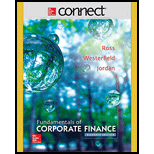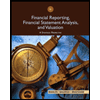
Connect 1 Semester Access Card for Fundamentals of Corporate Finance
11th Edition
ISBN: 9781259289392
Author: Stephen A. Ross Franco Modigliani Professor of Financial Economics Professor, Randolph W Westerfield Robert R. Dockson Deans Chair in Bus. Admin., Bradford D Jordan Professor
Publisher: McGraw-Hill Education
expand_more
expand_more
format_list_bulleted
Question
Chapter 13.7, Problem 13.7ACQ
Summary Introduction
To discuss: The fundamental relationship that exists between the risk and returns in a well-regulated market.
Introduction:
The reward-to-risk ratio indicates the
Where,
“E (Ri)” refers to the expected return on a risky asset
“Rf” refers to the risk-free rate
“βi” refers to the beta coefficient of the risky asset
Expert Solution & Answer
Want to see the full answer?
Check out a sample textbook solution
Students have asked these similar questions
A brief introduction and overview of the company"s (a) uk vodaphone (b) uk Hsbc bank, (c)uk coca-cola history and current position in respective marketplace.
King’s Park, Trinidad is owned and operated by a private company,Windy Sports Ltd. You work as the Facilities Manager of the Park andthe CEO of the company has asked you to evaluate whether Windy shouldembark on the expansion of the facility given there are plans by theGovernment to host next cricket championship.The project seeks to increase the number of seats by building fournew box seating areas for VIPs and an additional 5,000 seats for thegeneral public. Each box seating area is expected to generate $400,000in incremental annual revenue, while each of the new seats for thegeneral public will generate $2,500 in incremental annual revenue.The incremental expenses associated with the new boxes and seatingwill amount to 60 percent of the revenues. These expenses includehiring additional personnel to handle concessions, ushering, andsecurity. The new construction will cost $15 million and will be fullydepreciated (to a value of zero dollars) on a straight-line basis overthe 5-year…
You are called in as a financial analyst to appraise the bonds of Ollie’s Walking Stick Stores. The $5,000 par value bonds have a quoted annual interest rate of 8 percent, which is paid semiannually. The yield to maturity on the bonds is 12 percent annual interest. There are 12 years to maturity. a. Compute the price of the bonds based on semiannual analysis. b. With 8 years to maturity, if yield to maturity goes down substantially to 6 percent, what will be the new price of the bonds?
Chapter 13 Solutions
Connect 1 Semester Access Card for Fundamentals of Corporate Finance
Ch. 13.1 - How do we calculate the expected return on a...Ch. 13.1 - In words, how do we calculate the variance of the...Ch. 13.2 - What is a portfolio weight?Ch. 13.2 - How do we calculate the expected return on a...Ch. 13.2 - Is there a simple relationship between the...Ch. 13.3 - What are the two basic parts of a return?Ch. 13.3 - Under what conditions will a companys announcement...Ch. 13.4 - Prob. 13.4ACQCh. 13.4 - Prob. 13.4BCQCh. 13.5 - What happens to the standard deviation of return...
Ch. 13.5 - What is the principle of diversification?Ch. 13.5 - Why is some risk diversifiable? Why is some risk...Ch. 13.5 - Why cant systematic risk be diversified away?Ch. 13.6 - Prob. 13.6ACQCh. 13.6 - What does a beta coefficient measure?Ch. 13.6 - True or false: The expected return on a risky...Ch. 13.6 - How do you calculate a portfolio beta?Ch. 13.7 - Prob. 13.7ACQCh. 13.7 - What is the security market line? Why must all...Ch. 13.7 - Prob. 13.7CCQCh. 13.8 - If an investment has a positive NPV, would it plot...Ch. 13.8 - What is meant by the term cost of capital?Ch. 13 - Prob. 13.1CTFCh. 13 - Prob. 13.5CTFCh. 13 - Beta is a measure of what?Ch. 13 - The slope of the security market line is equal to...Ch. 13 - Where would a negative net present value project...Ch. 13 - Prob. 1CRCTCh. 13 - Prob. 2CRCTCh. 13 - Systematic versus Unsystematic Risk [LO3] Classify...Ch. 13 - Systematic versus Unsystematic Risk [LO3] Indicate...Ch. 13 - Prob. 5CRCTCh. 13 - Diversification [LO2] True or false: The most...Ch. 13 - Portfolio Risk [LO2] If a portfolio has a positive...Ch. 13 - Beta and CAPM[LO4] Is it possible that a risky...Ch. 13 - Corporate Downsizing [LO1] In recent years, it has...Ch. 13 - Earnings and Stock Returns [LO1] As indicated by a...Ch. 13 - Determining Portfolio Weights [LO1] What are the...Ch. 13 - Portfolio Expected Return [LO1] You own a...Ch. 13 - Portfolio Expected Return [LO1] You own a...Ch. 13 - Prob. 4QPCh. 13 - Prob. 5QPCh. 13 - Prob. 6QPCh. 13 - Calculating Returns and Standard Deviations [LO1]...Ch. 13 - Calculating Expected Returns [LO1] A portfolio is...Ch. 13 - Returns and Variances [LO1] Consider the following...Ch. 13 - Returns and Standard Deviations [LO1] Consider the...Ch. 13 - Calculating Portfolio Betas [LO4] You own a stock...Ch. 13 - Calculating Portfolio Betas [LO4] You own a...Ch. 13 - Using CAPM[LO4] A stock has a beta of 1.15, the...Ch. 13 - Using CAPM[LO4] A stock has an expected return of...Ch. 13 - Using CAPM [LO4] A stock has an expected return of...Ch. 13 - Using CAPM [LO4] A stock has an expected return of...Ch. 13 - Using the SML[LO4] Asset W has an expected return...Ch. 13 - Reward-to-Risk Ratios [LO4] Stock Y has a beta of...Ch. 13 - Reward-to-Risk Ratios [LO4] In the previous...Ch. 13 - Using CAPM [LO4] A stock has a beta of 1.14 and an...Ch. 13 - Portfolio Returns [LO2] Using information from the...Ch. 13 - Prob. 22QPCh. 13 - Portfolio Returns and Deviations [LO2] Consider...Ch. 13 - Analyzing a Portfolio [LO2, 4] You want to create...Ch. 13 - Analyzing a Portfolio [LO2, 4] You have 100,000 to...Ch. 13 - Systematic versus Unsystematic Risk [LO3] Consider...Ch. 13 - SML [LO4] Suppose you observe the following...Ch. 13 - SML [LO4] Suppose you observe the following...Ch. 13 - Prob. 1MCh. 13 - Beta is often estimated by linear regression. A...Ch. 13 - Prob. 3MCh. 13 - Prob. 4MCh. 13 - Prob. 5M
Knowledge Booster
Similar questions
- Lonnie is considering an investment in the Cat Food Industries. The $10,000 par value bonds have a quoted annual interest rate of 12 percent and the interest is paid semiannually. The yield to maturity on the bonds is 14 percent annual interest. There are seven years to maturity. Compute the price of the bonds based on semiannual analysis.arrow_forwardNeed solution this wuarrow_forwardneed assarrow_forward
arrow_back_ios
SEE MORE QUESTIONS
arrow_forward_ios
Recommended textbooks for you
 EBK CONTEMPORARY FINANCIAL MANAGEMENTFinanceISBN:9781337514835Author:MOYERPublisher:CENGAGE LEARNING - CONSIGNMENT
EBK CONTEMPORARY FINANCIAL MANAGEMENTFinanceISBN:9781337514835Author:MOYERPublisher:CENGAGE LEARNING - CONSIGNMENT Financial Reporting, Financial Statement Analysis...FinanceISBN:9781285190907Author:James M. Wahlen, Stephen P. Baginski, Mark BradshawPublisher:Cengage Learning
Financial Reporting, Financial Statement Analysis...FinanceISBN:9781285190907Author:James M. Wahlen, Stephen P. Baginski, Mark BradshawPublisher:Cengage Learning Intermediate Financial Management (MindTap Course...FinanceISBN:9781337395083Author:Eugene F. Brigham, Phillip R. DavesPublisher:Cengage Learning
Intermediate Financial Management (MindTap Course...FinanceISBN:9781337395083Author:Eugene F. Brigham, Phillip R. DavesPublisher:Cengage Learning

EBK CONTEMPORARY FINANCIAL MANAGEMENT
Finance
ISBN:9781337514835
Author:MOYER
Publisher:CENGAGE LEARNING - CONSIGNMENT

Financial Reporting, Financial Statement Analysis...
Finance
ISBN:9781285190907
Author:James M. Wahlen, Stephen P. Baginski, Mark Bradshaw
Publisher:Cengage Learning

Intermediate Financial Management (MindTap Course...
Finance
ISBN:9781337395083
Author:Eugene F. Brigham, Phillip R. Daves
Publisher:Cengage Learning